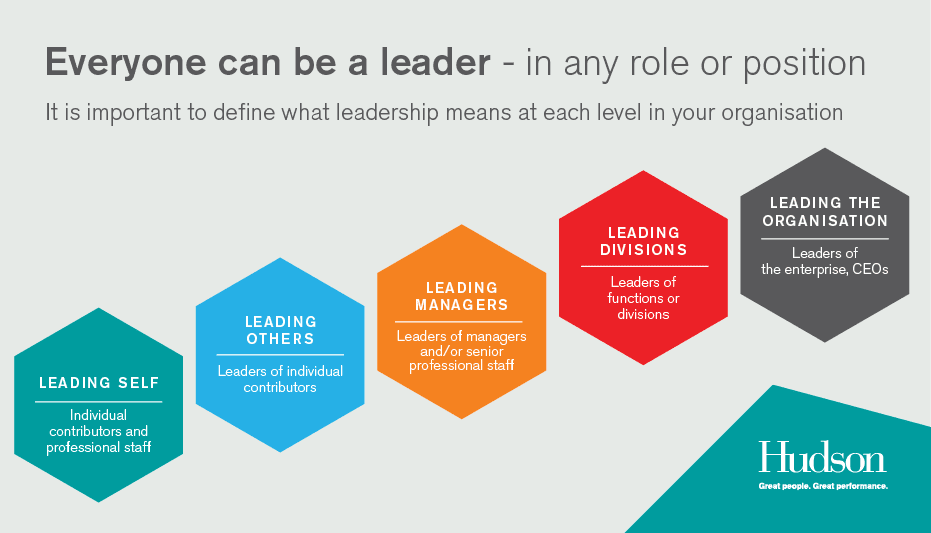Leadership: Why we all need to start thinking, and acting, ‘like a boss’

I have a question for every professional reading this: Do you consider yourself a leader?
If your answer to that was “No”, it might be time to re-think how you approach your job and your career.
Acting like a leader should not just be left to managers and senior leaders. Personally, I’ve never been a believer in hierarchy for hierarchy’s sake. Instead I am a strong advocate for the notion that anyone can be a leader, in any role or position.
This concept has become increasingly important because we now live and work in the age of VUCA (volatility, uncertainty, complexity, ambiguity). It’s an environment where organisations must evolve and innovate continually and quickly – and the best way to do that is by tapping into the collective wisdom and talent of their people, and by creating an environment where leaders can emerge at every level of an organisation.
Who are today’s leaders? Everyone
What makes a good leader? Hudson defines leadership as “making others better as a result of your presence, uniting them towards common goals, and ensuring that impact lasts in your absence”.
In our perspective, leaders who thrive in today’s business environment are driven, with an appetite to learn and grow; courageous and resilient in the face of uncertainty and change; mentally flexible and able to make sense of disparate and conflicting information; decisive in ambiguous circumstances; and capable of connecting with a diverse range of stakeholders and inspiring a shared sense of purpose.
These are all behaviours and capabilities that can be demonstrated by anyone at any level. But it requires that individuals embrace ownership and accountability, take the lead in their areas of expertise, and focus on making a positive impact.
This is what acting like a leader is all about.
What leadership at all levels looks like
While leadership behaviours can be demonstrated at all levels, these behaviours evolve and are expressed differently as you move from being an individual contributor to formal people and business management roles.
Let’s take one of the most important leadership qualities as an example: the ability to unleash potential and talent in other people.
If you’re an individual contributor, that might look like sharing your experience and knowledge with others in your team, and providing assistance, as well as constructive feedback.
For people managers, it would involve adapting your leadership style to different situations, creating learning opportunities for your team, facilitating collaboration within and between teams, and ensuring your staff take ownership and responsibility for the projects they’re involved in.
Effective leaders in today’s world also embrace diversity. Individual contributors could demonstrate this by being open to different opinions, collaborating with people from different disciplines and other parts of the business, and relating well to those from different cultural backgrounds.
At an executive level, this leadership capability might involve ensuring your workforce has the right diversity characteristics to support performance, creativity and innovation, and creating an organisational structure and culture that provides opportunities for different parts of the organisation to connect and work together.
Creating a leadership culture
Of course, individuals can only demonstrate leadership behaviours to the extent that the organisations they work in support them to do so – that’s the other vital side of the equation.
Creating a culture that encourages leadership behaviours requires a) people to understand that they CAN demonstrate leadership without necessarily being in a management role, and b) having an organisational structure and culture that empowers and supports people to take ownership of what they’re doing, take measured risks and build relationships with a diverse range of stakeholders.
Why does it matter?
Building leadership capability throughout an organisation is one of the best things a business can do. It is well established that leadership is directly linked to an organisation’s bottom line results. Can you imagine the potential impacts and outcomes if leadership behaviours were consistently demonstrated by individuals across all levels of your organisation? Not only would there likely be a financial upturn for the business, employee engagement and satisfaction would also improve.
Now is the time for ALL of us to act as leaders. The age of VUCA demands it.
5 ways to unleash your leadership potential:
- Develop your resilience.You need to build courage and resilience to deal with the change and uncertainty of today’s VUCA environment.
-
Be curious.Seek to understand yourself as well as your environment. Be curious to explore your own leadership capabilities and potential.
-
Know your ‘why’.Understand your purpose, and the contribution you want to make in work and life; without this clarity it will be very difficult to be inspirational.
-
Develop your social and emotional intelligence.These interpersonal capabilities will help you to effectively connect with different individuals and collaborate to achieve a shared purpose.
-
Push yourself outside your comfort zone.Stretch yourself to achieve challenging goals and continue to learn and grow, all the time.
Related insights
Event: Wow
Hudson recently decentralised its activity to better serve each employer’s requirements - with one objective in mind: get the job to be done.
Wed 01 Feb, 12am
Hiring: Managing workplace culture in the time of COVID-19
Culture and engagement are critical factors in driving organisational performance, and yet they have had to be re-invented during the COVID-19 disruptions. The hip office, workplace drinks, onsite gym and days off for birthdays, plus the casual banter around the water cooler: these are all aspects of work which go into creating a cohesive and…


